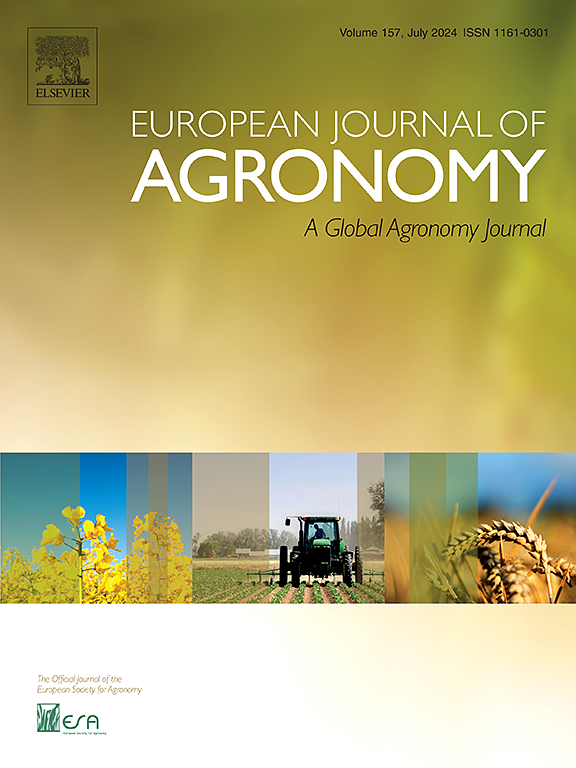Climate, altitude, yield, and varieties drive lodging in sugarcane: A random forest approach to predict risk levels on a tropical island
IF 4.5
1区 农林科学
Q1 AGRONOMY
引用次数: 0
Abstract
Lodging is a critical factor in reducing sugarcane yields worldwide, mainly due to the selection of highly productive varieties. Understanding the response of yield and lodging to the combined effects of climate, sugarcane traits, and varieties has become a priority under climate change. The aim of this study was to better understand the influence of plant characteristics, climate, and soil conditions on the trade-off between sugarcane yield and lodging on the tropical Reunion Island. Data from a 14-year experimental network run by the eRcane breeding institute were used to build random-forest models to predict sugarcane yield and lodging classes, i.e. <10 %, 10–50 %, >50 % of lodging. Yield and lodging probability were then predicted across the island using climate change projections from 2015 to 2035. Both yield and lodging were highly influenced by the variety and characteristics (height and tillering) and climatic conditions. Areas on the island at high altitudes were subject to high probability of lodging (>50 %), while in areas with high wind speed, the risk of moderate lodging (10–50 %) increased. Overall, conditions or plant characteristics that favor higher yields increased lodging probability. Nevertheless, the correlation between yield and lodging probability varied considerably depending on the variety, highlighting the importance of sugarcane characteristics in resistance to lodging. This study highlights the fact that promoting more productive varieties in recent decades has led to an increase in lodging and identified critical environments on the island prone to increased risk of lodging.
气候、海拔、产量和品种是甘蔗宿根病的诱因:预测热带岛屿风险水平的随机森林方法
宿根现象是全球甘蔗减产的一个关键因素,这主要是由于选择了高产品种造成的。了解产量和宿根对气候、甘蔗性状和品种的综合影响的反应已成为气候变化下的当务之急。本研究旨在更好地了解热带留尼汪岛上植物特性、气候和土壤条件对甘蔗产量和宿根性之间权衡的影响。研究利用甘蔗育种研究所(eRcane breeding institute)14 年的实验网络数据建立随机森林模型,预测甘蔗产量和宿根等级,即宿根率为 10%、10-50% 和 50%。然后,根据 2015 年至 2035 年的气候变化预测,对全岛的产量和宿根发生概率进行预测。产量和抽穗受品种和特性(高度和分蘖)以及气候条件的影响很大。岛上海拔较高的地区发生棉结的概率较高(50%),而在风速较高的地区,中度棉结(10%-50%)的风险增加。总体而言,有利于高产的条件或植物特性会增加棉结的概率。然而,不同品种的甘蔗产量和虫蛀几率之间的相关性差异很大,这凸显了甘蔗特性在抗虫蛀方面的重要性。这项研究强调了近几十年来推广高产品种导致宿根现象增加的事实,并确定了岛上易增加宿根风险的关键环境。
本文章由计算机程序翻译,如有差异,请以英文原文为准。
求助全文
约1分钟内获得全文
求助全文
来源期刊

European Journal of Agronomy
农林科学-农艺学
CiteScore
8.30
自引率
7.70%
发文量
187
审稿时长
4.5 months
期刊介绍:
The European Journal of Agronomy, the official journal of the European Society for Agronomy, publishes original research papers reporting experimental and theoretical contributions to field-based agronomy and crop science. The journal will consider research at the field level for agricultural, horticultural and tree crops, that uses comprehensive and explanatory approaches. The EJA covers the following topics:
crop physiology
crop production and management including irrigation, fertilization and soil management
agroclimatology and modelling
plant-soil relationships
crop quality and post-harvest physiology
farming and cropping systems
agroecosystems and the environment
crop-weed interactions and management
organic farming
horticultural crops
papers from the European Society for Agronomy bi-annual meetings
In determining the suitability of submitted articles for publication, particular scrutiny is placed on the degree of novelty and significance of the research and the extent to which it adds to existing knowledge in agronomy.
 求助内容:
求助内容: 应助结果提醒方式:
应助结果提醒方式:


